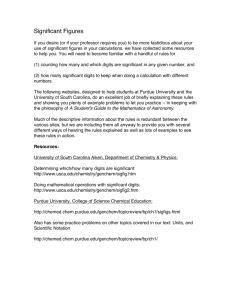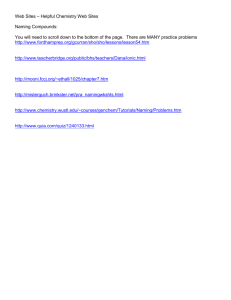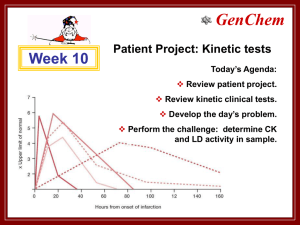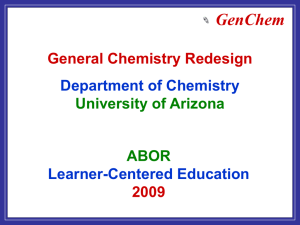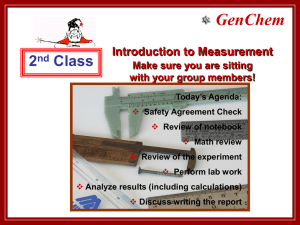Fischer Esterification
advertisement
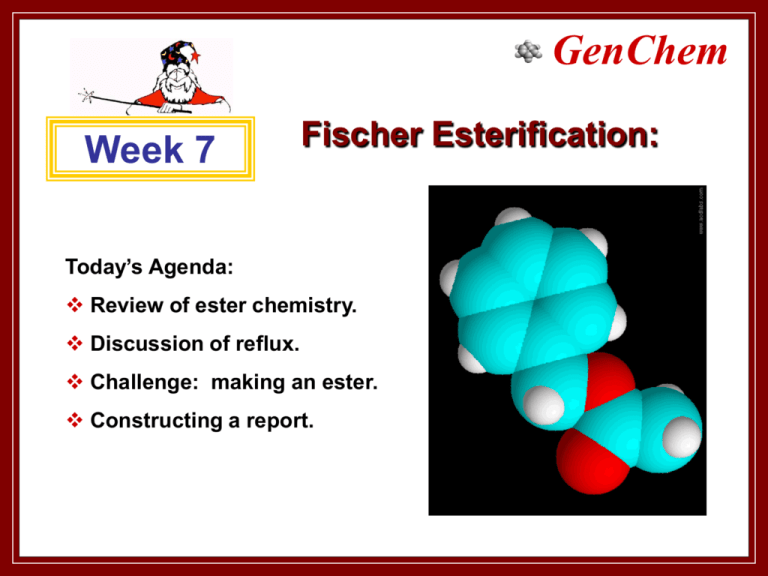
GenChem
Week 7
Fischer Esterification:
Today’s Agenda:
Review of ester chemistry.
Discussion of reflux.
Challenge: making an ester.
Constructing a report.
Patient Project
Assignments Made
Today
GenChem
Representatives from the Nursing College
will give a guest presentation in the 101b
lecture class regarding the patient project.
To be prepared for this presentation you
will need to be familiar with your patient's
history and physical exam. Ideally you
should bring (or have access to) a copy of
the history and physical exam. You will
likely find having this information extremely
useful for your encounter with the Nursing
College guest.
Patient Project Pages
Your Patient
GenChem
Each Group is assigned one of the following
patients to diagnose.
B.L. - a 24 year old female who presents to the emergency room with
complaints of shortness of breath, emesis and drowsiness.
K.O. - a 38 year old male who was knocked unconscious in an amateur boxing
event.
L.K. - a 56 year old obese male who presents to the emergency room with
crushing chest pain and diaphoresis.
O.T. - a 61 year old female who appears her stated age. She arrived in the ER
with the chief complaint of chest pain of several hours duration with
radiation to the left arm.
C.F. - a 72 year old female who was a direct admit to the telemetry unit from her
family practice doctor’s office. She complains of fatigue and shortness of
breath with any exertion.
S.T. - a 20 year old male who presented to the emergency room with complaints
of “pounding heart”, nausea and tingling sensations in both hands and his
left arm.
GenChem
THE
MIDTERM EXAM.
Next Week:
You will have 60 minutes to
complete. There is a study guide
posted to D2L.
Instructions for Students
All questions must be answered on the answer sheet. You must be clear
where your answers are. Calculations must be presented as in a lab report.
Three parts. Units and sig. figs are important.
Figures and graphs must be properly labeled.
Explanations must be concise and complete. Remember that you are
demonstrating to your instructor how well you understand the chemistry.
You will be graded on how well you justify your answers.
When you are asked to suggest ways to accomplish a task it is expected
that you will use examples that you have used this semester in this lab class.
A Sampling
GenChem
The following is a sample of the type of questions to be employed. To successfully complete the whole test you would
need to be able to complete these questions in 10 minutes or less.
The following paragraph describes a laboratory situation in which a student makes some bad safety decisions. List five
unsafe things that the student did, and briefly describe what should have been done instead.
{followed by a paragraph describing the behavior of a student in lab}
Short answer policy questions.
(a) If your chemicals start burning in an uncontrolled manner, what should you do? What if that fails?
{there will be a total of 10 such questions}
The following question is taken from an old test and covers an experiment we no longer
perform. There will be a total of five such questions.
The aluminum chloride test is a qualitative test for the presence of aromatic rings in
organic molecules. The test is performed by splashing some of an unknown compound
onto a small sample of solid aluminum chloride. A student performed the test on a number
of compounds and obtained the results shown in the table.
(a) Write a description of a positive test for aromatic ring structures.
(b) An unknown sample causes the aluminum chloride to take on a Green color. What can
you say about that unknown?
(c) It is known that certain ketones can cause the aluminum chloride to take on an orange
color. If you have an unknown that gives an orange color how would you go about
deciding if it really is aromatic?
Compound
Benzene
Toluene
Napthalene
Cyclohexe
ne
Color of Aluminum
chloride
Red
Orange
Blue
Pale yellow
GenChem
Let′s think!
What is an Ester
What do you know about esters?
No, not Esther!
GenChem
Let’s apply
How can we make an ester?
+ n H2 O
The reaction of an acid with an alcohol
will produce an ester and water.
GenChem
Fischer
Esterification
Pre-lab
GenChem
Let′s think!
The Reaction
In your groups review your responses to the
following pre-lab question and come up with a
consensus answer.
Using the Summary of Steps
given in chapter 11 of the lab
book as a guide and the
experiment guide prepare a set of
directions for performing the
reaction.
Let′s think!
GenChem
Check to see your procedure
includes the following
The reaction flask will be 10 mL in size.
Recommended amounts of chemicals. 1.5 mL of the alcohol, 3 mL of
glacial acetic acid and two to three drops of concentrated sulfuric acid.
Order of addition: Put the alcohol in the flask, mass the alcohol, and
then add acetic acid. Swirl to mix. Follow with 2-3 drops sulfuric acid
Any water present in your glassware will lower the ester yield. Make
sure your glassware is dry!
Do not add the sulfuric acid before the acetic acid!
The reaction mixture must reflux for 60 to 70 minutes. At the end of
this time raise the reaction flask out of the heating mantle.
Reflux pointers
know the mass of alcohol
added,
screw the flask on snugly,
suspend the flask above the
bottom of the heating mantle.
use a mini-hood to vent the
fumes from the reflux
condenser.
have your instructor check
your setup BEFORE turning on
the heat.
GenChem
GenChem
Let′s think!
The Extraction
In your groups review your responses to the
following pre-lab question and come up with a
consensus answer.
Using the Summary of Steps
given in section 11-3 of the lab
book and the notes from the
experiment guide as your guides
prepare a set of directions for
extracting the ester from the
reaction mixture. Make sure to
include all the materials and
equipment you expect to use.
Let′s think!
Extraction
Pointers
GenChem
Notice that you
will use a
centrifuge tube
rather than a
separatory
funnel to perform
the extraction.
You will use sodium bicarbonate.
Make sure you know:
what the bicarbonate does,
why you watch for CO2
evolution, and
where your ester is.
Let′s think!
GenChem
Drying
After extracting your ester
you will need to dry it. This
will be accomplished with
anhydrous sodium sulfate.
Make sure you know:
how the anhydrous sodium sulfate
works as a drying agent.
GenChem
WARNING!
Don’t throw anything
away until you are
SURE you know
where your product is!
Once you have your
product make sure you
securely store it in
your locker.
GenChem
Let′s explore!
Your Challenge
Every student is to prepare their own assigned
ester. Remember to have your instructor check
your setup before turning on the heat.
Available resources:
reflux kit containing: 10
mL RB flask, stirbar,
vacuum hose and funnel.
alcohol and acid.
You have
90 minutes
Let’s apply
GenChem
What remains to be done?
Characterization using a molecular probe.
The infrared (IR) spectrum of your compound
will provide information about its identity and
its purity, especially water.
GenChem
The Worksheet
You will now complete a
worksheet for this
experiment.
To be submitted BEFORE
leaving class:
Raw data. A copy of all
measurements and observations
you collected in lab.
A completed worksheet.
If you don’t finish the worksheet
in class you are to submit it
tomorrow to the wooden
dropbox outside the TSO
